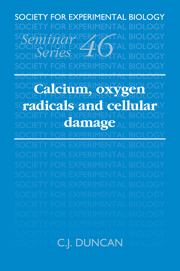Book contents
- Frontmatter
- Contents
- List of Contributors
- Preface
- 1 Are there common biochemical pathways in cell damage and cell death?
- 2 Free radicals in the pathogenesis of tissue damage
- 3 Calcium and signal transduction in oxidative cell damage
- 4 Regulation of neutrophil oxidant production
- 5 Reperfusion arrhythmias: role of oxidant stress
- 6 Biochemical pathways that lead to the release of cytosolic proteins in the perfused rat heart
- 7 Malignant hyperthermia: the roles of free radicals and calcium?
- 8 Free radicals, calcium and damage in dystrophic and normal skeletal muscle
- 9 Ultrastructural changes in mitochondria during rapid damage triggered by calcium
- 10 The importance of oxygen free radicals, iron and calcium in renal ischaemia
- 11 The Rubicon Hypothesis: a quantal framework for understanding the molecular pathway of cell activation and injury
- Index
2 - Free radicals in the pathogenesis of tissue damage
Published online by Cambridge University Press: 18 January 2010
- Frontmatter
- Contents
- List of Contributors
- Preface
- 1 Are there common biochemical pathways in cell damage and cell death?
- 2 Free radicals in the pathogenesis of tissue damage
- 3 Calcium and signal transduction in oxidative cell damage
- 4 Regulation of neutrophil oxidant production
- 5 Reperfusion arrhythmias: role of oxidant stress
- 6 Biochemical pathways that lead to the release of cytosolic proteins in the perfused rat heart
- 7 Malignant hyperthermia: the roles of free radicals and calcium?
- 8 Free radicals, calcium and damage in dystrophic and normal skeletal muscle
- 9 Ultrastructural changes in mitochondria during rapid damage triggered by calcium
- 10 The importance of oxygen free radicals, iron and calcium in renal ischaemia
- 11 The Rubicon Hypothesis: a quantal framework for understanding the molecular pathway of cell activation and injury
- Index
Summary
Free radicals are by definition atoms or groups of atoms containing an unpaired electron. For many years it was felt that such reactive molecules were in the realm of inorganic chemists and had no real relevance to biology and medicine, but in recent years substantial numbers of papers have been published providing evidence of the involvement of free-radical-mediated reactions in various pathological (and some physiological) situations. Perhaps the most completely studied of these processes in the hepatotoxicity which results from carbon tetrachloride exposure (Slater, Cheeseman & Ingold, 1985), while the area which has attracted most attention is the possibility that free radical species mediate the damage to tissues which occurs during ischaemia and reperfusion of tissues, such as the heart following myocardial infarction (McCord, 1985; Ytrehus et al., 1987; Badylak et al., 1987). This chapter will briefly review potential sources of free radicals in vivo, the body's protective mechanisms against radicals and the inherent problems in studying these processes during tissue damage.
Cellular sources of free radicals
The presence of an unpaired electron can convey considerable (potentially uncontrolled) reactivity to the free radical and the body therefore generally relies on enzymatic catalysis of reactions which do not involve free radicals. There are however a number of exceptions to this rule in which endogenous production of free radicals occurs during aspects of normal aerobic metabolism. The superoxide anion [O2−] is produced by several cell redox systems including xanthine oxidase and membraneassociated NADPH oxidase.
- Type
- Chapter
- Information
- Calcium, Oxygen Radicals and Cellular Damage , pp. 11 - 16Publisher: Cambridge University PressPrint publication year: 1991
- 3
- Cited by

